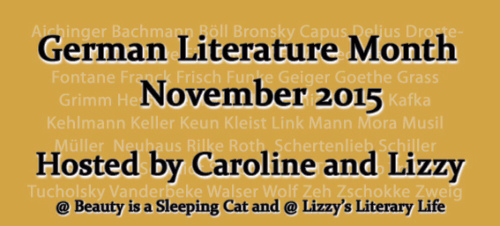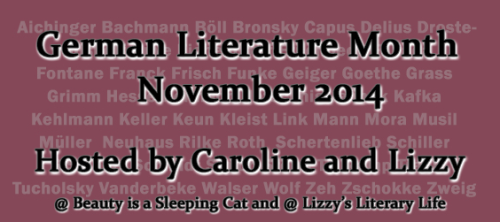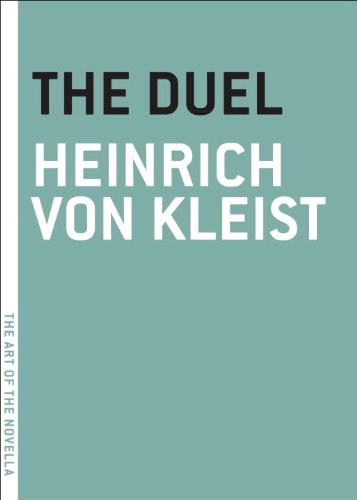As the last read for German Literature Month hosted by Caroline from Beauty is a Sleeping Cat and Lizzy from Lizzy’s Literary Life, in November, I thought I will read two novellas and a short story. This is what I read.
The Sandman by E.T.A.Hoffmann

‘The Sandman’ was first recommended to me by Bina from ‘If You Can Read This’. I finally got a chance to read it today. It is about a young man called Nathaniel, who has lived his childhood fearing someone called ‘The Sandman’. When it is bedtime, his mother tells him that he should go to sleep as otherwise the Sandman will come and take him away. At one point, Nathaniel hears footsteps coming into their house and his mother hurriedly takes him away to his bedroom. Nathaniel thinks it is the actual Sandman entering their home. One day he wants to see the Sandman with his own eyes. So he hides inside his father’s room and waits for this mysterious person. During the appropriate time of the night, the mysterious stranger arrives. He is an old acquaintance of the family whom no one likes. But interestingly, this stranger and Nathaniel’s father get to work on something which looks like sorcery or an alchemical experiment. He screams and faints and is in delirium for weeks. This mysterious person stops coming to their house. A year passes. Then suddenly this mysterious stranger comes back, something happens inside his father’s room, there is an explosion and the father dies. The image of the Sandman is forever seared inside Nathaniel’s heart. Later, after many years, when he is a student at the university, he meets someone who sells barometers and he looks like the mysterious stranger who used to visit his father. Nathaniel gets scared and worried and depressed. An unknown fear possesses him. He writes about this to his fiancée and her brother, who is also his friend. Then strange things start happening in his life. The surprising and tragic turns that Nathaniel’s life takes form the rest of the story.
‘The Sandman’ was eerie and scary. I can imagine why it is such a popular classic. We don’t know whether the fears of Nathaniel are based on reality or are a product of his own imagination. At one point Nathaniel’s fiancée writes this to him :
“If there is a dark and hostile power, laying its treacherous toils within us, by which it holds us fast and draws us along the path of peril and destruction, which we should not otherwise have trod; if, I say there is such a power, it must form itself inside us and out of ourselves, indeed; it must become identical with ourselves. For it is only in this condition that we can believe in it, and grant it the room which it requires to accomplish its secret work. Now, if we have a mind which is sufficiently firm, sufficiently strengthened by the joy of life, always to recognize this strange enemy as such, and calmly to follow the path of our own inclination and calling, then the dark power will fail in its attempt to gain a form that shall be a reflection of ourselves. Lothaire adds that if we have willingly yielded ourselves up to the dark powers, they are known often to impress upon our minds any strange, unfamiliar shape which the external world has thrown in our way; so that we ourselves kindle the spirit, which we in our strange delusion believe to be speaking to us. It is the phantom of our own selves, the close relationship with which, and its deep operation on our mind, casts us into hell or transports us into heaven.”
I found that passage quite powerful. The story also asks some questions on what is possible with science and technology – whether human-like machines can be created. It is interesting that Hoffmann thought about this in the early 19th century.
Another passage I liked in the novella was where the narrator of the story wonders how he can start a story. It goes like this :
“I was puzzled how to begin Nathaniel’s story in a manner as inspiring, original and striking as possible. ‘Once upon a time,’ the beautiful beginning of every tale, was too tame. ‘In the little provincial town of S____ lived’ – was somewhat better, as it at least prepared for the climax. Or should I dart at once, medias in res, with “‘Go to the devil,” cried the student Nathaniel with rage and horror in his wild looks, when the barometer-dealer, Giuseppe Coppola . . .?'”
Interesting analysis of how to start a story, isn’t it? It made me remember Kleist, who includes an unexpected event in the first sentence of his stories and grabs the reader’s attention.
I want to read more stories by Hoffmann now. If you would like to read ‘The Sandman’ online, you can find it here.
You can find other reviews of this novella, here :
Caroline’s Review
Nymeth’s Review
The Jews’ Beech by Annette von Droste-Hülshoff

‘The Jews’ Beech’ was recommended by Caroline in her ’14 German Women Writers You Shouldn’t Miss’ post. As it was short, I thought I will read it. I also found the writer’s name interesting – she must be the writer with the longest name whose work I have read J It is about the life and times of a boy called Friedrich Mergel. The story starts in 1738 and ends towards the end of the 18th century. How this boy grows up to become a young man and the experience he goes through and the strange happenings in the village where he lives form the story. There are thieves who come to the forest near the village and cut trees without permission. The rangers try to catch them but the thieves repeatedly evade them. During this time, one of the rangers is killed. Nobody knows what happened. Some suspicion falls on Friedrich, but he has an alibi. Friedrich has an uncle who seems to have a mysterious background and there is another boy called Johannes who is, strangely, Friedrich’s lookalike. What happens across the years and how the fortunes of Friedrich turn out form the rest of the story.
One of the passages from the book, which I really liked, came on the first page of the story and went like this :
It is difficult to view that period impartially. Since its disappearance, it has been either arrogantly criticised or absurdly praised, because those who experienced it are blinded by too many dear memories and those born later do not understand it.
I read two translations of ‘The Jews’ Beech’ online – here and here. The first one seemed to be closer to the original as it had long sentences and traditional words and constructs. I started with that, but when I lost track of an important element of the story, I went and read the second translation, which had shorter sentences and modern words. However, there were some issues I had with the second translation – for example Friedrich’s mother’s name was anglicized from Margrethe to Margaret. And Johannes Neimand’s name to John Nobody. It made me wonder what is more important in a translation – whether the story has to be conveyed clearly to the reader or whether the style of the author in the original book should be preserved. It made me appreciate the difficulties and intricacies of translation and how one translated version could vary significantly from another.
The Beggar Woman of Locarno by Heinrich von Kleist
This is a short story by Kleist, which I found here. It is about a beggar woman who is taken into a Marquis’ castle and lives in one of the rooms. Unfortunately, one day the Marquis asks her roughly to move from her corner to near the stove and when the old woman is trying to do that she slips and falls and injures her spine and dies in agony. In later years, the Marquis is not doing well financially and wants to sell-off his castle. Unfortunately the beggar woman’s ghost haunts the room where she lived her last days and the impact this has on the Marquis and his wife forms the rest of the story.
I have read only longer short stories and novellas by Kleist till now. This was a ‘short short’ and was around two pages. So it was a breezy read. Kleist also didn’t have the space to squeeze in so many characters in the story, like he normally does J Even then he manages to sneak in four characters!
On German Literature Month
I had a wonderful time during German Literature Month. It was fun to read new writers and works that I haven’t read before. I discovered many wonderful new writers whose works I would like to explore in the future. I also won two Kleist novellas in a giveaway and I liked both of them very much. My only regret was that I wanted to read a couple of thick books – ‘Every Man Dies Alone’ by Hans Fallada and ‘Ink Heart’ by Cornelia Funke – but because I was away from blogging for a week, I couldn’t do that. I really wanted to read Fallada’s book. I hope to read it next month. When I look at the books I had read, I discovered that I had read lots of novellas and short stories – 7 novellas, 17 short stories. I also read three novels. I hope to read more novels next time.
Lots of thanks to Caroline and Lizzy for hosting German Literature Month. Congratulations to all the participants for participating and thanks for all the wonderful posts. I am already looking forward to ‘German Literature Month’ next year.
Read Full Post »










